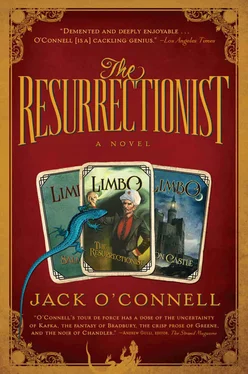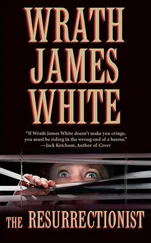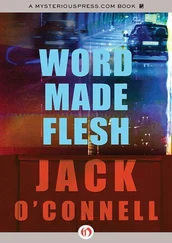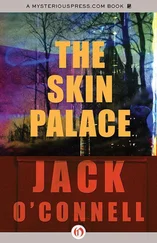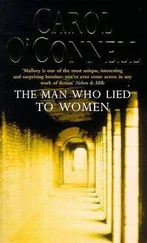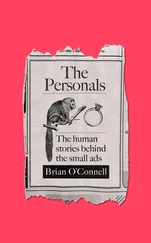Jack O'Connell - The Resurrectionist
Здесь есть возможность читать онлайн «Jack O'Connell - The Resurrectionist» весь текст электронной книги совершенно бесплатно (целиком полную версию без сокращений). В некоторых случаях можно слушать аудио, скачать через торрент в формате fb2 и присутствует краткое содержание. Год выпуска: 2009, Издательство: Algonquin Books, Жанр: Современная проза, на английском языке. Описание произведения, (предисловие) а так же отзывы посетителей доступны на портале библиотеки ЛибКат.
- Название:The Resurrectionist
- Автор:
- Издательство:Algonquin Books
- Жанр:
- Год:2009
- ISBN:нет данных
- Рейтинг книги:4 / 5. Голосов: 1
-
Избранное:Добавить в избранное
- Отзывы:
-
Ваша оценка:
- 80
- 1
- 2
- 3
- 4
- 5
The Resurrectionist: краткое содержание, описание и аннотация
Предлагаем к чтению аннотацию, описание, краткое содержание или предисловие (зависит от того, что написал сам автор книги «The Resurrectionist»). Если вы не нашли необходимую информацию о книге — напишите в комментариях, мы постараемся отыскать её.
those who create them and those who consume them. About the nature of consciousness and the power of the unknown. And, ultimately, about forgiveness and the depth of our need to extend it and receive it.
The Resurrectionist — читать онлайн бесплатно полную книгу (весь текст) целиком
Ниже представлен текст книги, разбитый по страницам. Система сохранения места последней прочитанной страницы, позволяет с удобством читать онлайн бесплатно книгу «The Resurrectionist», без необходимости каждый раз заново искать на чём Вы остановились. Поставьте закладку, и сможете в любой момент перейти на страницу, на которой закончили чтение.
Интервал:
Закладка:
Near the end of the voyage, on a particularly foggy night, Sweeney took the complete Limbo story and began to throw it overboard, one issue at a time, like some kind of ritual. In the moonlight, he glanced at one garish cover after another and then let it drop into the ship’s wake, watching it float for a moment or two before it sank into the blackness of the sea.
He spied Bruno swimming for the coast of Gehenna, Kitty on his back, the unconscious chicken boy cradled in one bulging arm as the strongman kicked the trio to safety. Sweeney focused in on the swimmer’s face, looking, perhaps, for a sign of realization regarding the moment’s meaning. And then he tossed the issue over the ship’s rail.
Next he perused a tawdry death scene, showers of scarlet blood frozen midspurt as Lazarus Cole was pummeled to death by the enraged dozen. Sweeney saw the rocks and bricks, pipes and plates crashing down on the magician’s body, tearing flesh, breaking bone, thrashing the skull until the brain began to turn itself off. This time, Sweeney closed his eyes for a moment as he sailed the comic into the dark and salty air.
When he opened them, he saw that the wind had selected a particular image in the last issue of Limbo and he looked down on a full page depiction of Chick, prone atop his own coffin lid, floating out into the watery expanse as the sun rose and his family folded itself, member by member, into unique shrouds of grief along the shore.
And as he studied this picture, Sweeney thought about all the places where the story’s creator had gone wrong, fallen down on the job. It was as if the artist had come to hate his characters and his audience. And for Sweeney, this was a helpful exercise in learning how to craft his own tales.
Some stories, the Limbo author had written, do not have a happy ending.
And some stories, Sweeney would counter, have no ending at all. Were he to meet and confront this Menlo, the creator of Limbo, Sweeney would insist that some stories sail on and on, moving, perhaps, beyond their maker’s vision, but floating, nonetheless, into worlds unknown. Carried by currents of need, whose source we may never discover.
If it is true that Danny was shattered by a story, then maybe it follows that he can be remade by a story. In this regard, Sweeney has ideas. Notions of wandering and adventure, of transgression and sorrow, penance and reconciliation. Beyond this, Sweeney has hundreds of sheets of medical reports and a surgical marker. And it is possible that this is all he needs for a communion of minds and shared memories. For a true dream in which human freaks engage an abominable world. And sometimes redeem it.
THE FATHER DROPSthe last issue of Limbo into the sea and takes a seat next to his boy. Rene sits unmoving on Danny’s shoulder, like some tiny, scaly parrot, studying the horizon. Sweeney pulls the cap off the marker, lifts the papers into his lap, turns his head and glances at his sleeping son.
Then he looks out at the black, unending ocean. And over time and miles, he begins to see the chicken boy, resting, unmoving on a slab of wood, on the splintered altar of a coffin door. Chick is bobbing on the ocean’s waves, free from the flock of gulls that had circled and swooped for days, maybe weeks. Neither hungry nor thirsty anymore, he lives on story now, as he rides in perfect rhythm with the sea.
Dreaming that he is cruising on a tramp freighter to the old world, where his patriarch awaits. Dreaming of sanctuary and serenity. Of reunion and communion and the last and best redemption.
Dreaming of that moment on the horizon when he will open his bill, separate the maxilla from the mandible. When, by thought alone, he will release those keratin hinges that smell of cherry and coconut.
Dreaming of that instant when he will come fully awake, and open his beak and deliver the words that advance the story and make the future possible.
“I forgive you.”
Reading
Confessions of a Comic Book Dilettante by Jack O’Connell from The Algonkian, Spring/Summer 2008
EDITOR’S NOTE: Comic books have been a part of our popular culture for decades, and in many ways they are a startlingly accurate reflection of the times in which they were written. For Jack O’Connell, author of The Resurrectionist, a lifetime of comics have inspired him to create a world filled with benign, even lovable, sideshow freaks, whose comic book story unfolds as a parallel to the “real world” of a rust-belt city in postindustrial New England.
I admit it. I’m one of those writers so enamored of fiction that I elevate its needs and its virtues and its abilities above those of history. Should I ever find a way to fashion my sedate life into a memoir, my compulsion to invent would make James Frey blush and shudder.
So, I want to insist that as a kid I was firmly lodged on the extreme and foggy cutting edge. That back in the sixties, when my peers were spinning the Monkees, I was pondering the psychedelia of Roky Erickson. That while my neighborhood buddies were lining up to see The Love Bug, I was sneaking into the balcony to witness Midnight Cowboy. And that while my pals were kicking back and reading about Superman’s latest go-round with Lex Luthor, I was awash in the mystic sputterings of Mr. Natural and the pharmacological safaris of the Fabulous Furry Freak Brothers.
I would like to insist that all of that happened, but I’d cave and admit the truth. Or, at the very least, the closest approximation of the truth of which I’m capable.
My novel, The Resurrectionist, is chock-full of comic books. Which might lead the reader to suspect that the same could be said of my childhood. In fact, my relationship with comics while growing up was fleeting, sporadic, and haphazard. I would like nothing better than to report warm memories of readings of The Hulk and Green Lantern and The Fantastic Four. But the truth is a little more prosaic, if not less revelatory.
From about 1967 or so, the only comic book I read regularly was Treasure Chest —“the Catholic Comic Book,” as the slogan baldly proclaimed. I’ve always believed that TC was the product of a rare compromise among the black-habited nuns of my youth. I can still imagine them, encircled like Shakespearean crones around a bubbling cauldron, some ancient Mother Superior deciding All right, if they must read comic books, they’ll read our comic book!
Treasure Chest featured the wholesome adventures of Chuck White, an All-American Boy running forever through the suburbs of the American Century collecting moral lessons. Think Leave It to Beaver without the edginess. The fact is, I loved the pulpy thing in all its cheery, dogmatic glory. And to this day, there’s a box of them moldering away in my attic.
In general, comic books for me were a summertime phenomenon. But when my father walked my siblings and me up to the beachfront penny candy store, and I stood before those wire spin racks, I’m embarrassed to admit that, unlike so many of my demographic cohorts, I did not select the coolness that was Marvel or D.C. I strolled home along the boardwalk, grasping Archie and any number of imprints from the Harvey line— Sad Sack, Richie Rich, Little Lotta.
There is an almost unbearable innocence attached to my memories of these comic books. They are so utterly of another era that they feel nearly archaic to me. And in this way they stand as polar opposites to the comic book that appears repeatedly in my novel.
That comic book is called Limbo, and it tells the story of a group of circus freaks and their wanderings through a bizarre landscape in search of sanctuary from a murderous pursuer. Limbo is a dark, adult, complex story. I like to think of it as what might have developed had Kafka snuck up on The Adventures of Tintin creator Hergé, stabbed the artist to death with his own charcoal pencil, and then highjacked the story.
Читать дальшеИнтервал:
Закладка:
Похожие книги на «The Resurrectionist»
Представляем Вашему вниманию похожие книги на «The Resurrectionist» списком для выбора. Мы отобрали схожую по названию и смыслу литературу в надежде предоставить читателям больше вариантов отыскать новые, интересные, ещё непрочитанные произведения.
Обсуждение, отзывы о книге «The Resurrectionist» и просто собственные мнения читателей. Оставьте ваши комментарии, напишите, что Вы думаете о произведении, его смысле или главных героях. Укажите что конкретно понравилось, а что нет, и почему Вы так считаете.
